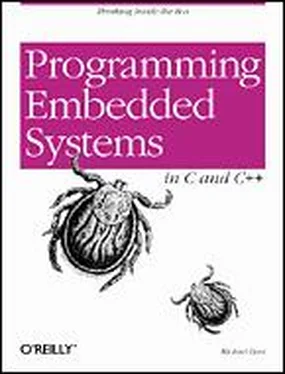Michael Barr - Programming Embedded Systems in C and C++
Здесь есть возможность читать онлайн «Michael Barr - Programming Embedded Systems in C and C++» весь текст электронной книги совершенно бесплатно (целиком полную версию без сокращений). В некоторых случаях можно слушать аудио, скачать через торрент в формате fb2 и присутствует краткое содержание. Год выпуска: 1999, ISBN: 1999, Издательство: O'Reilly, Жанр: Программирование, Компьютерное железо, на английском языке. Описание произведения, (предисловие) а так же отзывы посетителей доступны на портале библиотеки ЛибКат.
- Название:Programming Embedded Systems in C and C++
- Автор:
- Издательство:O'Reilly
- Жанр:
- Год:1999
- ISBN:1-56592-354-5
- Рейтинг книги:5 / 5. Голосов: 1
-
Избранное:Добавить в избранное
- Отзывы:
-
Ваша оценка:
- 100
- 1
- 2
- 3
- 4
- 5
Programming Embedded Systems in C and C++: краткое содержание, описание и аннотация
Предлагаем к чтению аннотацию, описание, краткое содержание или предисловие (зависит от того, что написал сам автор книги «Programming Embedded Systems in C and C++»). Если вы не нашли необходимую информацию о книге — напишите в комментариях, мы постараемся отыскать её.
Programming Embedded Systems in C and C++ — читать онлайн бесплатно полную книгу (весь текст) целиком
Ниже представлен текст книги, разбитый по страницам. Система сохранения места последней прочитанной страницы, позволяет с удобством читать онлайн бесплатно книгу «Programming Embedded Systems in C and C++», без необходимости каждый раз заново искать на чём Вы остановились. Поставьте закладку, и сможете в любой момент перейти на страницу, на которой закончили чтение.
Интервал:
Закладка:
Begin by making a list of the external peripherals. Depending on your application, this list might include LCD or keyboard controllers, A/D converters, network interface chips, or custom ASICs (Application-Specific Generated Circuits). In the case of the Arcom board, the list contains just three items: the Zilog 85230 Serial Controller, parallel port, and debugger port.
You should obtain a copy of the user's manual or databook for each device on your list. At this early stage of the project, your goal in reading these documents is to understand the basic functions of the device. What does the device do? What registers are used to issue commands and receive the results? What do the various bits and larger fields within these registers mean? When, if ever, does the device generate interrupts? How are interrupts acknowledged or cleared at the device?
When you are designing the embedded software, you should try to break the program down along device lines. It is usually a good idea to associate a software module called a device driver with each of the external peripherals. This is nothing more than a collection of software routines that control the operation of the peripheral and isolate the application software from the details of that particular hardware device. I'll have a lot more to say about device drivers in Chapter 7.
5.6 Initialize the Hardware
The final step in getting to know your new hardware is to write some initialization software. This is your best opportunity to develop a close working relationship with the hardware — especially if you will be developing the remainder of the software in a high-level language. During hardware initialization it will be impossible to avoid using assembly language. However, after completing this step, you will be ready to begin writing small programs in C or C++. [13] In order to make the example in Chapter 2, a little easier to understand, I didn't show any of the initialization code there. However, it is necessary to get the hardware initialization code working before you can write even simple programs like Blinking LED.
If you are one of the first software engineers to work with a new board — especially a prototype — the hardware might not work as advertised. All processor-based boards require some amount of software testing to confirm the correctness of the hardware design and the proper functioning of the various peripherals. This puts you in an awkward position when something is not working properly. How do you know if the hardware or your software is to blame? If you happen to be good with hardware or have access to a simulator, you might be able to construct some experiments to answer this question. Otherwise, you should probably ask a hardware engineer to join you in the lab for a joint debugging session.
The hardware initialization should be executed before the startup code described in Chapter 3. The code described there assumes that the hardware has already been initialized and concerns itself only with creating a proper runtime environment for high-level language programs. Figure 5-4 provides an overview of the entire initialization process, from processor reset through hardware initialization and C/C++ startup code to main .
Figure 5-4. The hardware and software initialization process
The first stage of the initialization process is the reset code. this is a small piece of assembly (usually only two or three instructions) that the processor executes immediately after it is powered on or reset. The sole purpose of this code is to transfer control to the hardware initialization routine. The first instruction of the reset code must be placed at a specific location in memory, usually called the reset address, that is specified in the processor databook. The reset address for the 80188EB is FFFF0h.
Most of the actual hardware initialization takes place in the second stage. At this point, we need to inform the processor about its environment. This is also a good place to initialize the interrupt controller and other critical peripherals. Less critical hardware devices can be initialized when the associated device driver is started, usually from within main .
Intel's 80188EB has several internal registers that must be programmed before any useful work can be done with the processor. These registers are responsible for setting up the memory and I/O maps and are part of the processor's internal chip-select unit. By programming the chip-select registers, you are essentially waking up each of the memory and I/O devices that are connected to the processor. Each chip-select register is associated with a single "chip enable" wire that runs from the processor to some other chip. The association between particular chip-selects and hardware devices must be established by the hardware designer. All you need to do is get a list of chip-select settings from him and load those settings into the chip-select registers.
Upon reset, the 80188EB assumes a worst-case scenario. It assumes there are only 1024 bytes of ROM-located in the address range FFC00h to FFFFFh — and that no other memory or I/O devices are present. This is the processor's "fetal position," and it implies that the hw_init routine must be located at address FFC00h (or higher). It must also not require the use of any RAM. The hardware initialization routine should start by initializing the chip-select registers to inform the processor about the other memory and I/O devices that are installed on the board. By the time this task is complete, the entire range of ROM and RAM addresses will be enabled, so the remainder of your software can be located at any convenient address in either ROM or RAM.
The third initialization stage contains the startup code. this is the assembly-language code that we saw back in Chapter 3. In case you don't remember, its job is to the prepare the way for code written in a high-level language. Of importance here is only that the startup code calls main . From that point forward, all of your other software can be written in C or C++.
Hopefully, you are starting to understand how embedded software gets from processor reset to your main program. Admittedly, the very first time you try to pull all of these components together (reset code, hardware initialization, C/C++ startup code, and application) on a new board there will be problems. So expect to spend some time debugging each of them. Honestly, this will be the hardest part of the project. You will soon see that once you have a working Blinking LED program to fall back on, the work just gets easier and easier — or at least more similar to ordinary computer programming.
Up to this point in the book we have been building the infrastructure for embedded programming. But the topics we're going to talk about in the remaining chapters concern higher-level structures: memory tests, device drivers, operating systems, and actually useful programs. These are pieces of software you've probably seen before on other computer systems projects. However, there will still be some new twists related to the embedded programming environment.
Chapter 6. Memory
Tyrell:If we give them a past, we create a cushion for their emotions and, consequently, we can control them better.
Deckard: Memories. You're talking about memories.
the movie Blade RunnerIn this chapter, you will learn everything you need to know about memory in embedded systems. In particular, you will learn about the types of memory you are likely to encounter, how to test memory devices to see if they are working properly, and how to use Flash memory.
6.1 Types of Memory
Many types of memory devices are available for use in modern computer systems. As an embedded software engineer, you must be aware of the differences between them and understand how to use each type effectively. In our discussion, we will approach these devices from a software viewpoint. As you are reading, try to keep in mind that the development of these devices took several decades and that there are significant physical differences in the underlying hardware. The names of the memory types frequently reflect the historical nature of the development process and are often more confusing than insightful.
Читать дальшеИнтервал:
Закладка:
Похожие книги на «Programming Embedded Systems in C and C++»
Представляем Вашему вниманию похожие книги на «Programming Embedded Systems in C and C++» списком для выбора. Мы отобрали схожую по названию и смыслу литературу в надежде предоставить читателям больше вариантов отыскать новые, интересные, ещё непрочитанные произведения.
Обсуждение, отзывы о книге «Programming Embedded Systems in C and C++» и просто собственные мнения читателей. Оставьте ваши комментарии, напишите, что Вы думаете о произведении, его смысле или главных героях. Укажите что конкретно понравилось, а что нет, и почему Вы так считаете.












